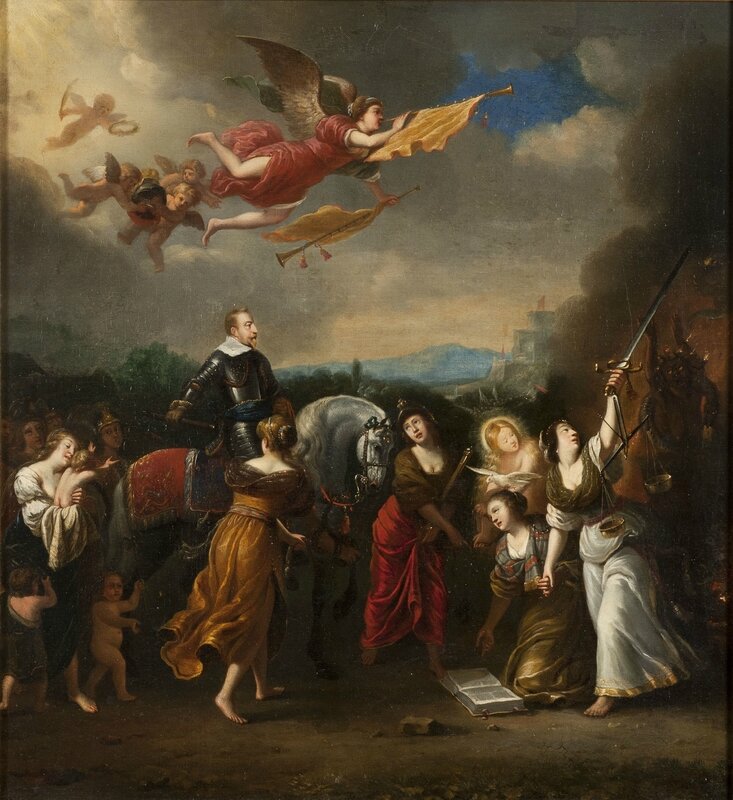Exhibition illustrates the global diversity and effective history of Protestantism
Martin Luther in the Circle of Reformers, 1625/1650 © Deutsches Historisches Museum
BERLIN.- For the first time an exhibition will illustrate the global diversity and effective history of Protestantism, but also its potential for engendering conflict between different cultures.
What traces of Protestantism can be found in other denominations, religions and concepts of life? How did it change itself through these encounters – and not least of all, in what ways have people adopted and appropriated the Protestant doctrine, how have they shaped it and lived it? The exhibition “The Luther Effect” tells a global story of effect and counter-effect that begins around 1500 and continues on into the present present. It is depicted using the examples of Germany and Europe 1450–1600, Sweden 1500–1750, North America 1600–1900, Korea 1850–2000 and present-day Tanzania.
King Edward VI and the Pope, around 1575 © National Portrait Gallery, London.
The Deutsches Historisches Museum is presenting the exhibition in the Martin- Gropius-Bau on a area of some 3,000 m2 and bringing together outstanding exponents from national and international lenders, many of which have never before been displayed in Germany. Supplementing the exhibition are numerous cultural and educational events and fringe programmes. A richly illustrated catalogue will also be published.
The Deutsches Historisches Museum’s presentation is one of three special national exhibitions commemorating the 500th anniversary of the Reformation in the year 2017. Besides Berlin, the Federal Government Commissioner for Culture and the Media is supporting the exhibitions in the Wartburg in Eisenach and the “Lutherstadt” Wittenberg. The exhibitions are under the patronage of Federal President Joachim Gauck. The German Savings Bank Finance Group is the principal sponsor of the exhibition “The Luther Effect. Protestantism – 500 Years in the World”. This exhibition is supported by the Museum Association of the German Historical Museum.
Emblem of the Geuzen “Liver Turcx dan Pavs” (Better Turk than Papist), 1574 © Rijksmuseum, Amsterdam
Maria Aurora and Amélie Wilhelmine von Königsmarck, swearing-in of the representatives of the estates on the Bible and the Swedish Book of Law, around 1690 © Östergötlands Museum, Linköping
Apotheosis of King Gustavus II Adolphus, around 1650 © Nationalmuseum Stockholm, Sweden.
“Dis sint de Sitten von Lappland” (These are the customs of Lapland), before 1668 © Staatliche Schlösser, Burgen und Gärten Sachsen, gemeinnützige GmbH, Burg Kriebstein/PUNCTUM/Bertram Kober.
Johann Valentin Haidt, First Fruits, 1748 © Unitätsarchiv der Evangelischen Brüder-Unität, Herrnhut; Unitätsarchiv: GS 463
Emanuel Gottlieb Leutze, Westward the Course of Empire Takes its Way, 1861 © Gilcrease Museum, Tulsa, Oklahoma.
The first Korean-language New Testament, 1887 © Bodleian Library, Oxford.
Korean translation of the Ten Commandments, 1911 © The Korean Christian Museum at Soongsil University, Seoul.
Missionary Franz Rietzsch (?), around 1930 © Unitätsarchiv der Evangelischen Brüder-Unität, Herrnhut / Stephan Schmorrde.
Morning Glory in the Lutheran Kariakoo Church in Dar es Salaam, June 2016 © Deutsches Historisches Museum / Karsten Hein.

/https%3A%2F%2Fprofilepics.canalblog.com%2Fprofilepics%2F1%2F0%2F100183.jpg)
/https%3A%2F%2Fstorage.canalblog.com%2F03%2F02%2F119589%2F96711876_o.jpg)
/https%3A%2F%2Fstorage.canalblog.com%2F11%2F31%2F119589%2F94773502_o.jpg)
/https%3A%2F%2Fstorage.canalblog.com%2F20%2F83%2F119589%2F94772815_o.jpg)
/https%3A%2F%2Fstorage.canalblog.com%2F26%2F72%2F119589%2F75604929_o.jpg)
/https%3A%2F%2Fstorage.canalblog.com%2F59%2F60%2F119589%2F26458628_o.jpg)














/image%2F1371349%2F20240508%2Fob_d997ec_d21e3e110569bdfa219529297300e28a-1402x.png)
/image%2F1371349%2F20240508%2Fob_4c468b_telechargement-4.jpg)
/image%2F1371349%2F20240508%2Fob_7c1cc0_telechargement.jpg)
/image%2F1371349%2F20240507%2Fob_6e4c73_telechargement-17.jpg)